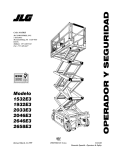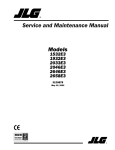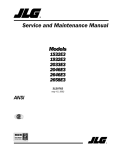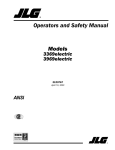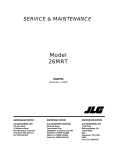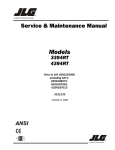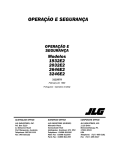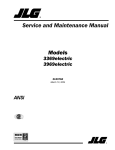Download Operators and Safety Manual
Transcript
Operators and Safety Manual Model 1532E3 1932E3 2033E3 2046E3 2646E3 2658E3 3120877 July 31, 2001 FOREWORD FOREWORD The purpose of this manual is to provide users with the operating procedures essential for the promotion of proper machine operation for its intended purpose. It is important to over-stress proper machine usage. All information in this manual should be READ and UNDERSTOOD before any attempt is made to operate the machine. YOUR OPERATING MANUAL IS YOUR MOST IMPORTANT TOOL - Keep it with the machine. REMEMBER ANY EQUIPMENT IS ONLY AS SAFE AS THE OPERATOR. BECAUSE THE MANUFACTURER HAS NO DIRECT CONTROL OVER MACHINE APPLICATION AND OPERATION, PROPER SAFETY PRACTICES ARE THE RESPONSIBILITY OF THE USER AND HIS OPERATING PERSONNEL. ALL INSTRUCTIONS IN THIS MANUAL ARE BASED ON THE USE OF THE MACHINE UNDER PROPER OPERATING CONDITIONS, WITH NO DEVIATIONS FROM THE ORIGINAL DESIGN. ALTERATION AND/OR MODIFICATION OF THE MACHINE IS STRICTLY FORBIDDEN, WITHOUT WRITTEN APPROVAL FROM JLG INDUSTRIES, PER OSHA REGULATIONS AND APPLICABLE ANSI STANDARDS. THIS SAFETY ALERT SYMBOL IS USED TO CALL ATTENTION TO POTENTIAL HAZARDS WHICH MAY LEAD TO SERIOUS INJURY OR DEATH IF IGNORED. Safety of personnel and proper use of the machine are of primary concern, DANGER, WARNING, CAUTION, IMPORTANT, INSTRUCTIONS and NOTE are inserted throughout this manual to emphasize these areas. They are defined as follows: DANGER INDICATES AN IMMINENTLY HAZARDOUS SITUATION WHICH, IF NOT AVOIDED WILL RESULT IN SERIOUS INJURY OR DEATH.] WARNING INDICATES A POTENTIALLY HAZARDOUS SITUATION WHICH, IF NOT AVOIDED COULD RESULT IN SERIOUS INJURY OR DEATH. CAUTION INDICATES A POTENTIALLY HAZARDOUS SITUATION WHICH, IF NOT AVOIDED, MAY RESULT IN MINOR OR MODERATE INJURY. IT MAY ALSO BE USED TO ALERT AGAINST UNSAFE PRACTICES IMPORTANT OR INSTRUCTIONS INDICATES A PROCEDURES ESSENTIAL FOR SAFE OPERATION AND WHICH, IF NOT FOLLOWED, MAY RESULT IN A MALFUNCTION OR DAMAGE TO THE MACHINE. JLG INDUSTRIES MAY HAVE ISSUED SAFETY RELATED BULLETINS FOR YOUR JLG PRODUCT. CONTACT JLG INDUSTRIES INC. OR THE LOCAL AUTHORIZED JLG DISTRIBUTOR FOR INFORMATION CONCERNING SAFETY RELATED BULLETINS WHICH MAY HAVE BEEN ISSUED FOR YOUR JLG PRODUCT. ALL ITEMS REQUIRED BY THE SAFETY RELATED BULLETINS MUST BE COMPLETED ON THE AFFECTED JLG PRODUCT Due to continuous product improvements, JLG Industries, Inc. reserves the right to make specification changes without prior notification. Contact JLG Industries, Inc. for updated information. 3120877 – JLG Sizzor – a FOREWORD This page left blank intentionally. b – JLG Sizzor – 3120877 FOREWORD All procedures herein are based on the use of the machine under proper operating conditions, with no deviations from original design intent... as per OSHA regulations and applicable ANSI standards. 5. All personnel in the platform shall, at all times, wear approved fall protection devices and other safety gear as required. 6. Load limits specified by the manufacturer shall not be exceeded. 7. Instruction and warning placards must be legible. READ & HEED! The ownership, use, service, and/or maintenance of this machine is subject to various governmental and local laws and regulations. It is the responsibility of the owner/user to be knowledgeable of these laws and regulations and to comply with them. The most prevalent regulations of this type in the United States are the Federal OSHA Safety Regulations*. Listed below, in abbreviated form are some of the requirements of Federal OSHA regulations in effect as of the date of publication of this handbook. The listing of these requirements shall not relieve the owner/user of the responsibility and obligation to determine all applicable laws and regulations and their exact wording and requirements, and to comply with the requirements. Nor shall the listing of these requirements constitute an assumption of responsibility of liability on the part of JLG Industries, Inc. 1. Only trained and authorized operators shall be permitted to operate the aerial lift. 2. A malfunctioning lift shall be shut down until repaired. 8. Aerial lifts may be field modified for uses other than those intended by the manufacturer only if certified in writing by the manufacturer to be in conformity to JLG requirements and to be at least as safe as it was prior to modification. 9. Aerial lifts shall not be used near electric power lines unless the lines have been de energized or adequate clearance is maintained. 10. Employees using aerial lifts shall be instructed on how to recognize and avoid unsafe conditions and hazards. 11. Ground controls shall not be operated unless permission has been obtained from personnel in the platform, except in case of an emergency. 12. Regular inspection of the job site and aerial lift shall be performed by competent persons. 13. Personnel shall always stand on the floor of the platform, not on boxes, planks, railing or other devices, for a work position. *Applicable Federal OSHA regulations for the United States, as of the date of publication of this manual, include, but are not limited to, 29 CFR 1910.67, 29 CFR 1926.20, 29 CFR 1926.21, 29 CFR 1926.28, and 29 CFR 1926.453. 3. The controls shall be plainly marked as to their function. 4. The controls shall be tested each day prior to use to determine that they are in safe operating condition. 3120877 – JLG Sizzor – c FOREWORD REVISON LOG January 1999 - Original Issue March 12, 1999 - Revised March 1, 2001 Revised July 31, 2001 Revised d – JLG Sizzor – 3120877 TABLE OF CONTENTS TABLE OF CONTENTS SUBJECT - SECTION, PARAGRAPH SECTION PAGE NO. - FOREWORD SECTION 1 - SAFETY PRECAUTIONS 1.1 1.2 1.3 1.4 1.5 General . . . . . . . . . . . . . . . . . . . . . . . . . . . . . . . . . . . . . . . . . . . . . . . . . . . . . . . . . . . . . . . . . . . . . .1-1 Pre-operation. . . . . . . . . . . . . . . . . . . . . . . . . . . . . . . . . . . . . . . . . . . . . . . . . . . . . . . . . . . . . . . . . .1-1 Operation. . . . . . . . . . . . . . . . . . . . . . . . . . . . . . . . . . . . . . . . . . . . . . . . . . . . . . . . . . . . . . . . . . . . .1-2 Towing, Lifting, and Hauling . . . . . . . . . . . . . . . . . . . . . . . . . . . . . . . . . . . . . . . . . . . . . . . . . . . . . .1-4 Additional Hazards / Safety. . . . . . . . . . . . . . . . . . . . . . . . . . . . . . . . . . . . . . . . . . . . . . . . . . . . . . .1-4 SECTION 2 - PREPARATION AND INSPECTION 2.1 2.2 2.3 2.4 2.5 2.6 2.7 General . . . . . . . . . . . . . . . . . . . . . . . . . . . . . . . . . . . . . . . . . . . . . . . . . . . . . . . . . . . . . . . . . . . . . .2-1 Preparation For Use . . . . . . . . . . . . . . . . . . . . . . . . . . . . . . . . . . . . . . . . . . . . . . . . . . . . . . . . . . . .2-1 Delivery and Frequent Inspection . . . . . . . . . . . . . . . . . . . . . . . . . . . . . . . . . . . . . . . . . . . . . . . . . .2-1 Daily Walk-Around Inspection. . . . . . . . . . . . . . . . . . . . . . . . . . . . . . . . . . . . . . . . . . . . . . . . . . . . .2-2 Daily Functional Check . . . . . . . . . . . . . . . . . . . . . . . . . . . . . . . . . . . . . . . . . . . . . . . . . . . . . . . . . .2-2 Torque Requirements . . . . . . . . . . . . . . . . . . . . . . . . . . . . . . . . . . . . . . . . . . . . . . . . . . . . . . . . . . .2-3 Battery Charging . . . . . . . . . . . . . . . . . . . . . . . . . . . . . . . . . . . . . . . . . . . . . . . . . . . . . . . . . . . . . . .2-3 SECTION 3 - USER RESPONSIBILITIES AND MACHINE CONTROL 3.1 3.2 3.3 3.4 3.5 General . . . . . . . . . . . . . . . . . . . . . . . . . . . . . . . . . . . . . . . . . . . . . . . . . . . . . . . . . . . . . . . . . . . . . .3-1 Personnel Training . . . . . . . . . . . . . . . . . . . . . . . . . . . . . . . . . . . . . . . . . . . . . . . . . . . . . . . . . . . . .3-1 Operating Characteristics and Limitations . . . . . . . . . . . . . . . . . . . . . . . . . . . . . . . . . . . . . . . . . . .3-1 Controls and Indicators . . . . . . . . . . . . . . . . . . . . . . . . . . . . . . . . . . . . . . . . . . . . . . . . . . . . . . . . . .3-2 Placards and Decals . . . . . . . . . . . . . . . . . . . . . . . . . . . . . . . . . . . . . . . . . . . . . . . . . . . . . . . . . . . .3-7 SECTION 4 - MACHINE OPERATION 4.1 4.2 4.3 4.4 4.5 4.6 4.7 4.8 4.9 4.10 4.11 4.12 Description . . . . . . . . . . . . . . . . . . . . . . . . . . . . . . . . . . . . . . . . . . . . . . . . . . . . . . . . . . . . . . . . . . .4-1 General . . . . . . . . . . . . . . . . . . . . . . . . . . . . . . . . . . . . . . . . . . . . . . . . . . . . . . . . . . . . . . . . . . . . . .4-1 Motor Operation . . . . . . . . . . . . . . . . . . . . . . . . . . . . . . . . . . . . . . . . . . . . . . . . . . . . . . . . . . . . . . .4-1 Raising and Lowering (Lifting) . . . . . . . . . . . . . . . . . . . . . . . . . . . . . . . . . . . . . . . . . . . . . . . . . . . .4-2 Platform Extension . . . . . . . . . . . . . . . . . . . . . . . . . . . . . . . . . . . . . . . . . . . . . . . . . . . . . . . . . . . . .4-3 Steering . . . . . . . . . . . . . . . . . . . . . . . . . . . . . . . . . . . . . . . . . . . . . . . . . . . . . . . . . . . . . . . . . . . . . .4-3 Traveling (Driving) . . . . . . . . . . . . . . . . . . . . . . . . . . . . . . . . . . . . . . . . . . . . . . . . . . . . . . . . . . . . . .4-3 Parking and Stowing . . . . . . . . . . . . . . . . . . . . . . . . . . . . . . . . . . . . . . . . . . . . . . . . . . . . . . . . . . . .4-4 Platform Loading . . . . . . . . . . . . . . . . . . . . . . . . . . . . . . . . . . . . . . . . . . . . . . . . . . . . . . . . . . . . . . .4-5 Safety Prop . . . . . . . . . . . . . . . . . . . . . . . . . . . . . . . . . . . . . . . . . . . . . . . . . . . . . . . . . . . . . . . . . . .4-5 transporting, Tie Down and Lifting . . . . . . . . . . . . . . . . . . . . . . . . . . . . . . . . . . . . . . . . . . . . . . . . .4-5 Towing . . . . . . . . . . . . . . . . . . . . . . . . . . . . . . . . . . . . . . . . . . . . . . . . . . . . . . . . . . . . . . . . . . . . . . .4-6 SECTION 5 - EMERGENCY PROCEDURES 5.1 5.2 5.3 5.4 5.5 General . . . . . . . . . . . . . . . . . . . . . . . . . . . . . . . . . . . . . . . . . . . . . . . . . . . . . . . . . . . . . . . . . . . . . .5-1 Incident Notification. . . . . . . . . . . . . . . . . . . . . . . . . . . . . . . . . . . . . . . . . . . . . . . . . . . . . . . . . . . . .5-1 Emergency Towing Procedures . . . . . . . . . . . . . . . . . . . . . . . . . . . . . . . . . . . . . . . . . . . . . . . . . . .5-1 Manual Descent System . . . . . . . . . . . . . . . . . . . . . . . . . . . . . . . . . . . . . . . . . . . . . . . . . . . . . . . . .5-1 Emergency Operation . . . . . . . . . . . . . . . . . . . . . . . . . . . . . . . . . . . . . . . . . . . . . . . . . . . . . . . . . . .5-1 SECTION 6 - INSPECTION AND REPAIR LOG 3120877 – JLG Sizzor – i TABLE OF CONTENTS (Continued) LIST OF FIGURES FIGURE NO. 2-1. 2-2. 2-3. 2-4. 2-5. 2-6. 3-1. 3-2. 3-3. 3-4. 3-5. 4-1. 4-2. 4-3. TITLE PAGE NO. Pothole Protection System Operation . . . . . . . . . . . . . . . . . . . . . . . . . . . . . . . . . . . . . . . . . . . . . .2-3 Daily Walk-Around Inspection Diagram . . . . . . . . . . . . . . . . . . . . . . . . . . . . . . . . . . . . . . . . . . . . .2-4 Daily Walk-Around Inspection Points (Sheet 1 of 2). . . . . . . . . . . . . . . . . . . . . . . . . . . . . . . . . . . .2-5 Daily Walk-Around Inspection Points (Sheet 2 of 2). . . . . . . . . . . . . . . . . . . . . . . . . . . . . . . . . . . .2-6 Lubrication Diagram . . . . . . . . . . . . . . . . . . . . . . . . . . . . . . . . . . . . . . . . . . . . . . . . . . . . . . . . . . . .2-7 Torque Chart . . . . . . . . . . . . . . . . . . . . . . . . . . . . . . . . . . . . . . . . . . . . . . . . . . . . . . . . . . . . . . . . . .2-8 Ground Control Station - Models 1532E3/1932E3 . . . . . . . . . . . . . . . . . . . . . . . . . . . . . . . . . . . . .3-3 Ground Control Station - Models 2033E3/2046E3/2646E3/2658E3 . . . . . . . . . . . . . . . . . . . . . . .3-4 Platform Control Station - All Models . . . . . . . . . . . . . . . . . . . . . . . . . . . . . . . . . . . . . . . . . . . . . . .3-5 Decal Location (left side). . . . . . . . . . . . . . . . . . . . . . . . . . . . . . . . . . . . . . . . . . . . . . . . . . . . . . . . .3-8 Decal Location (right side) . . . . . . . . . . . . . . . . . . . . . . . . . . . . . . . . . . . . . . . . . . . . . . . . . . . . . . .3-9 Grade and Sideslope . . . . . . . . . . . . . . . . . . . . . . . . . . . . . . . . . . . . . . . . . . . . . . . . . . . . . . . . . . .4-4 E3 Tie Down . . . . . . . . . . . . . . . . . . . . . . . . . . . . . . . . . . . . . . . . . . . . . . . . . . . . . . . . . . . . . . . . . .4-5 Lifting Chart . . . . . . . . . . . . . . . . . . . . . . . . . . . . . . . . . . . . . . . . . . . . . . . . . . . . . . . . . . . . . . . . . . .4-6 LIST OF TABLES TABLE NO. 1-1 2-1 6-1 ii TITLE PAGE NO. Minimum Safe Approach Distances (M.S.A.D.) . . . . . . . . . . . . . . . . . . . . . . . . . . . . . . . . . . . . . . .1-3 Lubrication Chart. . . . . . . . . . . . . . . . . . . . . . . . . . . . . . . . . . . . . . . . . . . . . . . . . . . . . . . . . . . . . . .2-7 Inspection and Repair Log . . . . . . . . . . . . . . . . . . . . . . . . . . . . . . . . . . . . . . . . . . . . . . . . . . . . . . .6-1 – JLG Sizzor – 3120877 SECTION 1 - SAFETY PRECAUTIONS SECTION 1. SAFETY PRECAUTIONS 1.1 • Do not operate this machine until complete training is performed by authorized persons. GENERAL This section outlines the necessary precautions for proper and safe machine usage and maintenance. For proper machine use, it is mandatory that a daily routine is established based on the content of this manual. A maintenance program, using the information provided in this manual and the Service and Maintenance Manual, must also be established by a qualified person and followed to ensure that the machine is safe to operate. • Only authorized and qualified personnel can operate the machine. The owner/user/operator/lessor/lessee of the machine should not operate this machine until this manual has been read, training is accomplished, and operation of the machine has been completed under the supervision of an experienced and qualified operator. • All operating personnel must be familiar with the emergency controls and emergency operation of the machine as specified in this manual. If there are any questions with regard to safety, training, inspection, maintenance, application, and operation, please contact JLG Industries, Inc. (“JLG”). • Read, understand, and obey all DANGERS, WARNINGS, CAUTIONS, and operating instructions on the machine and in this manual. • Use the machine in a manner which is within the scope of its intended application set by JLG. • Read, understand, and obey all applicable employer, local, and governmental regulations as they pertain to operation of the machine. Workplace Inspection • The operator is to take safety measures to avoid all hazards in the work area prior to machine operation. FAILURE TO COMPLY WITH THE SAFETY PRECAUTIONS LISTED IN THIS MANUAL COULD RESULT IN MACHINE DAMAGE, PROPERTY DAMAGE, PERSONAL INJURY OR DEATH. 1.2 • Do not operate the machine in hazardous environments unless approved for that purpose by JLG. PRE-OPERATION Operator Training and Knowledge • Read and understand this manual before operating the machine. 3120877 • Do not swing turntable or raise the platform while on trucks, trailers, railway cars, floating vessels, scaffolds or other equipment unless approved in writing by JLG. • Be sure that the ground conditions are able to support the maximum load shown on the decals located on the machine. • This machine can be operated in temperatures of -20o C to 40o C (0o F to 104o F). Consult JLG for operation outside this range. – JLG Lift – 1-1 SECTION 1 - SAFETY PRECAUTIONS Machine Inspection • Before machine operation, perform inspections and functional checks. Refer to Section 2 of this manual for detailed instructions. • Do not operate this machine until it has been serviced and maintained according to requirements specified in the Service and Maintenance Manual. • Be sure all safety devices are operating properly. Modification of these devices is a safety violation. • Do not operate any machine on which safety or instruction placards or decals are missing or illegible. • Avoid any buildup of debris on the platform floor. Keep mud, oil, grease, and other slippery substances from footwear and platform floor. 1.3 • Do not assist a stuck or disabled machine by pushing, pulling, or by using machine functions. Only pull the unit from the tie-down lugs on the chassis. • Stow elevating assembly and shut off all power before leaving machine. Trip and Fall Hazards • When operating a boom lift or vertical mast lift, occupants in the platform must wear a full body harness with a lanyard attached to an authorized lanyard anchorage point. When operating a scissor lift or vertical mast lift, JLG recommends wearing a full body harness. Attach only one (1) lanyard per lany ard anchorage point. OPERATION General • Do not use the machine for any purpose other than positioning personnel, their tools, and equipment. • Never operate a machine that is not working properly. If a malfunctions occurs, shut down the machine. • Before operating the machine, make sure all gates are closed and fastened or in their proper position. • Never slam a control switch or lever through neutral to an opposite direction. Always return switch to neutral and stop before moving the switch to the next function. Operate controls with slow and even pressure. • Hydraulic cylinders should never be left fully extended or fully retracted before shutdown or for long periods of time. • Do not allow personnel to tamper with or operate the machine from the ground with personnel in the platform, except in an emergency. • Do not carry materials directly on platform railing unless approved by JLG. • When two or more persons are in the platform, the operator shall be responsible for all machine operations. • Always ensure that power tools are properly stowed and never left hanging by their cord from the platform work area. • Supplies or tools which extend outside the platform are prohibited unless approved by JLG 1-2 • Keep both feet firmly positioned on the platform floor at all times. Never use ladders, boxes, steps, planks, or similar items on platform to provide additional reach. • Never use the elevating assembly to enter or leave the platform. • Use extreme caution when entering or leaving platform. Be sure that the platform is fully lowered. Face the machine, maintain “three point contact” with the machine, using two hands and one foot or two feet and one hand during entry and exit. • Check orientation of directional arrows on chassis before driving. The direction of drive and steer may be opposite from normal operation based upon orientation of chassis. – JLG Lift – 3120877 SECTION 1 - SAFETY PRECAUTIONS • Platform-to-structure transfers at elevated positions are discouraged. Where transfer is necessary, enter/exit through the gate only with the platform within 0.3m (1 ft) of a safe and secure structure. 100% tie-off is also required in this situation using two lanyards. One lanyard must be attached to the platform with the second lanyard attached to the structure. The lanyard connected to the platform must not be disconnected until the transfer to the structure is safe and complete. Table 1-1.Minimum Safe Approach Distances (M.S.A.D.) Electrocution Hazards • This machine is not insulated and does not provide protection from contact or proximity to electrical current. Voltage Range (Phase to Phase) MINIMUM SAFE APPROACH DISTANCE in Meters (Feet) 0 to 300V AVOID CONTACT Over 300V to 50 KV 3 (10) Over 50KV to 200 KV 5 (15) Over 200 KV to 350 KV 6(20) Over 350 KV to 500 KV 8 (25) Over 500 KV to 750 KV 11 (35) Over 750 KV to 1000 KV 14 (45) DO NOT MANEUVER MACHINE OR PERSONNEL INSIDE PROHIBITED ZONE (MSAD). ASSUME ALL ELECTRICAL PARTS AND WIRING ARE ENERGIZED UNLESS KNOWN OTHERWISE. Tipping Hazards • The user should be familiar with the surface before driving. Do not exceed the allowable sideslope and grade while driving.. • Maintain safe distance from electrical lines, apparatus, or any energized (exposed or insulated) parts according to the Minimum Safe Approach Distance (MSAD) as shown in Table 1-1. • Allow for machine movement and electrical line swaying. • Do not elevate platform or drive with platform elevated while on a sloping, uneven, or soft surface. • Before driving on floors, bridges, trucks, and other surfaces, check allowable capacity of the surfaces. • Never exceed the maximum platform capacity. Distribute loads evenly on platform floor. • Do not raise the platform or drive from an elevated position unless the machine is on firm, level surfaces and evenly supported. • Keep the chassis of the machine at least 2 ft. (0.6m) from holes, bumps, drop-offs, obstructions, debris, concealed holes, and other potential hazards on the floor/surface unless approved by JLG. • Never attempt to use the machine as a crane. Do not tie-off machine to any adjacent structure. 3120877 – JLG Lift – 1-3 SECTION 1 - SAFETY PRECAUTIONS • Do not operate the machine when wind conditions exceed the maximum allowable wind speed. • Do not increase the surface area of the platform or the load. Increase of the area exposed to the wind will decrease stability. • Do not increase the platform size with unauthorized deck extensions or attachments. • If elevating assembly or platform is in a position that one or more wheels are off the ground, all persons must be removed before attempting to stabilize the machine. Use cranes, forklift trucks, or other appropriate equipment to stabilize machine and remove personnel. Crushing and Collision Hazards • Approved head gear must be worn by all operating and ground personnel. • Keep hands and limbs out of the elevating assembly during operation. • Check work area for clearances overhead, on sides, and bottom of platform when lifting or lowering platform, and driving. • Exercise extreme caution at all times to prevent obstacles from striking or interfering with operating controls and persons in the platform. • Be sure that operators of other overhead and floor level machines are aware of the aerial work platform’s presence. Disconnect power to overhead cranes. • Warn personnel not to work, stand, or walk under a raised platform. Position barricades on floor if necessary. 1.4 TOWING, LIFTING, AND HAULING • Never allow personnel in platform while towing, lifting, or hauling. • This machine should not be towed, except in the event of emergency, malfunction, power failure, or loading/ unloading. Refer to the Emergency Procedures section of this manual for emergency towing procedures. • The platform must be completely empty of tools. • When lifting machine, lift only at designated areas of the machine. Lift with lifting equipment of adequate capacity. • Refer to the Machine Operation section of this manual for lifting information. 1.5 ADDITIONAL HAZARDS / SAFETY • Do not use machine as a ground for welding. • Do not refuel the machine with the engine running. • Battery fluid is highly corrosive. Avoid contact with skin and clothing at all times. • Charge batteries only in a well ventilated area. • During operation, keep all body parts inside platform railing. • Use elevating assembly functions, not the drive function to position the platform close to obstacles • Always post a lookout when driving in areas where vision is obstructed. • Keep non-operating personnel at least 1.8m (6 ft.) away from machine during all driving operations. • Limit travel speed according to conditions of ground surface, congestion, visibility, slope, location of personnel, and other factors which may cause collision or injury to personnel. • Be aware of stopping distances in all drive speeds. When driving in high speed, switch to low speed before stopping. Travel grades in low speed only. • Do not use high speed drive in restricted or close quarters or when driving in reverse. 1-4 – JLG Lift – 3120877 SECTION 2 - PREPARATION AND INSPECTION SECTION 2. PREPARATION AND INSPECTION 2.1 GENERAL This section provides the necessary information needed by those personnel that are responsible to place the machine in operation readiness, and lists checks that are performed prior to use of the machine. It is important that the information contained in this section be read and understood before any attempt is made to operate the machine. Ensure that all the necessary inspections have been completed successfully before placing the machine into service. These procedures will aid in obtaining maximum service life and safe operation. The following checklist provides a systematic inspection to assist in detecting defective, damaged, or improperly installed parts. The checklist denotes the items to be inspected and conditions to examine. Frequent inspection shall be performed monthly or more often when required by environment, severity, and frequency of usage. This checklist is also applicable and must be followed for all machines that have been in storage or for all machines that will be exposed to harsh or changing climates. These check are also to be performed after maintenance has been performed on the machine. Handrail Assemblies SINCE THE MACHINE MANUFACTURER HAS NO DIRECT CONTROL OVER THE FIELD INSPECTION AND MAINTENANCE, SAFETY IS THE RESPONSIBILITY OF THE OWNER/OPERATOR. Properly installed; no loose or missing parts; no visible damage. Platform Assembly 2.2 No visible damage; free of dirt and debris. PREPARATION FOR USE Before a new machine is put into operation it must be carefully inspected for any evidence of damage resulting from shipment and inspected periodically thereafter as outlined in the Delivery and Frequent Inspection. The unit should be thoroughly checked for hydraulic leaks during initial start-up and run. A check of all components should be made to assure their security. Sizzor Arms All preparations necessary to place the machine in operation readiness status are the responsibility of management personnel. Preparation requires good common sense, (i.e. lift works smoothly and brakes operate properly) coupled with a series of visual inspections. The mandatory requirements are given in the Daily Walk Around Inspection. Pivot Pins It should be assured that the items appearing in the Delivery and Periodic Inspection and Functional Check are complied with prior to putting the machine into service. 2.3 DELIVERY AND FREQUENT INSPECTION No visible damage, abrasions and/or distortions. Electrical Cable No visible damage; properly secured. No loose or missing retaining hardware; no visible damage; no evidence of pin or bushing wear. Lift Cylinder No rust, nicks, scratches or foreign material on piston rod; no leakage. Frame No visible damage; loose or missing hardware (top and underside). NOTE: This machine requires periodic safety and maintenance inspections by a JLG distributor, or certified JLG mechanic. Tire and Wheel Assemblies NOTE: An annual inspection shall be performed on the aerial platform no later than thirteen (13) months from the date of the prior annual inspection. The inspection shall be performed by person(s) certified as a mechanic on the specific make and model of the aerial platform. Sliding Wear Pad Blocks 3120877 No loose or missing lug nuts; no visible damage; check drive hoses for damage. No excessive wear. – JLG Sizzor – 2-1 SECTION 2 - PREPARATION AND INSPECTION Hydraulic Oil Supply Overall Cleanliness Operate lift function through one complete cycle before checking oil level. Oil level should be at full mark or within 1.5 cm (0.5 in) below full mark on side of hydraulic tank (all systems shut down, machine in stowed position); No visible oil leaks on the ground. Steer Cylinder No rust, nicks, scratches or foreign material on piston rod; no leakage. Check all standing surfaces for oil, fuel and hydraulic oil spillage and foreign objects. Ensure overall cleanliness. Placards Keep all information and operating placards clean and unobstructed. Cover when spray painting or shot blasting to protect legibility. Operators and Safety Manual Steer Linkage Ensure a copy of this manual is enclosed in the manual storage box. No loose or missing parts; no visible damage. Front Spindle Assemblies Machine Log No excessive wear; no damage; evidence of proper lubrication. Control Boxes (Platform and Ground) Switches operable; no visible damage; placards secure and legible; controller operable; no visible damage. Batteries Proper electrolyte level; cable connections tight; no visible damage; no corrosion at battery cable connections. Ensure batteries are fully charged. Ensure a machine operating record or log is kept. Check to see that it is current and that no entries have been left uncleared, leaving machine in an unsafe condition for operation. Daily Lubrication For those items pointed out in the Daily Walk-Around Inspection requiring daily lubrication, refer to the Lubrication Chart for specific requirements. 2.5 Motor/Pump Unit and Valves No leakage; units secure. DAILY FUNCTIONAL CHECK Perform functional checks in accordance with the Daily Functional Check before attempting to operate the machine. Platform Placards No visible damage; placards secure and legible. 2.4 DAILY WALK-AROUND INSPECTION It is the users responsibility to inspect the machine before the start of each workday. It is recommended that each user inspect the machine before operation, even if the machine has already been put into service under another user. This Daily Walk-Around Inspection is the preferred method of inspection. These checks are also to be performed after maintenance has been performed on the machine. In addition to the Daily Walk-Around Inspection, be sure to include the following as part of the daily inspection: 2-2 TO AVOID INJURY DO NOT OPERATE A MACHINE UNTIL ALL MALFUNCTIONS HAVE BEEN CORRECTED. USE OF A MALFUNCTIONING MACHINE IS A SAFETY VIOLATION. A functional check of all systems should be performed, under no load, once the walk-around inspection is complete, in an area free of overhead and ground level obstructions. Perform pre-load functional check in accordance with the following procedure: 1. Ensure batteries are fully charged. 2. Raise and lower platform several times. Check for smooth elevation and lowering. Check for High Drive cut-out as platform begins to raise. Check that pothole protection system is deployed when platform is raised and that actuating rollers are in contact with the connecting bar. – JLG Sizzor – 3120877 SECTION 2 - PREPARATION AND INSPECTION 2.7 BATTERY CHARGING At the end of the work day, the batteries should be charged for the next days work. Position the Emergency Stop switch to OFF. Prior to charging, be sure electrolyte covers plates. Connect the battery charger to a properly grounded receptacle using a suitable extension cord. Set the battery charger timer switch, if equipped, for the desired charging time. After charging, check the electrolyte level of the batteries and adjust accordingly. Add distilled water only to batteries. A fully charged battery will have a specific gravity of between 1.260 - 1.275 on a hydrometer. WHEN ADDING DISTILLED WATER TO THE BATTERIES, A NONMETALLIC CONTAINER AND/OR FUNNEL MUST BE USED. ADD WATER ONLY TO LEVEL INDICATOR OR 0.95 CM (3/8 INCH) ABOVE SEPARATORS. Figure 2-1. Pothole Protection System Operation NO OPEN FLAMES OR SMOKING WHEN CHARGING BATTERIES. 3. Drive forward and reverse, check for proper operation. 4. Check that drive brake holds when machine is driven up a hill, not to exceed rated gradeability, and stopped. 5. Steer left and right. Check for proper operation. 6. Check fluid level on hydraulic oil reservoir. Refer to the Lubrication Chart. 2.6 CHARGE BATTERIES ONLY IN A WELL VENTILATED AREA. ENSURE THAT BATTERY ACID DOES NOT COME INTO CONTACT WITH SKIN OR CLOTHING. NOTE: Be sure to disconnect and store any extension cords after charging batteries and before putting machine into service. To avoid electrolyte overflow, add distilled







































































